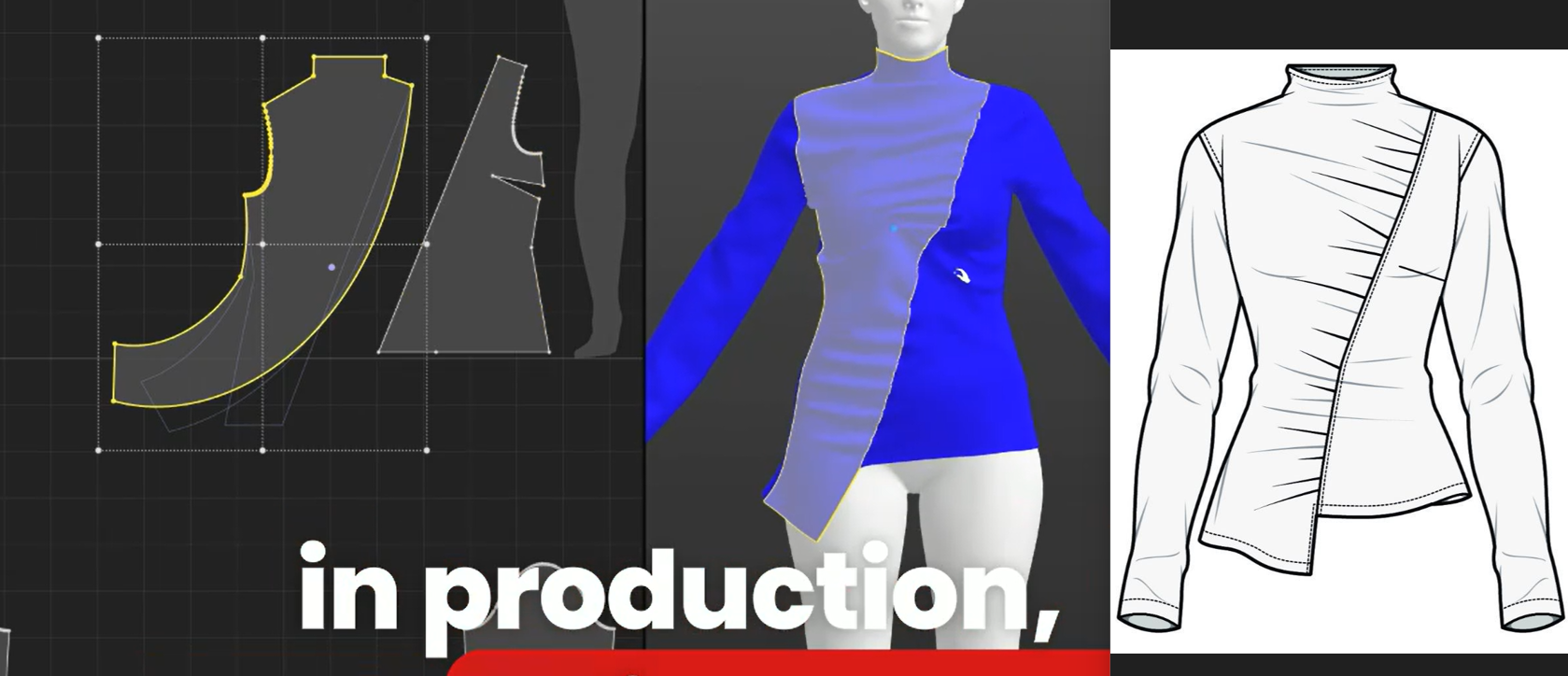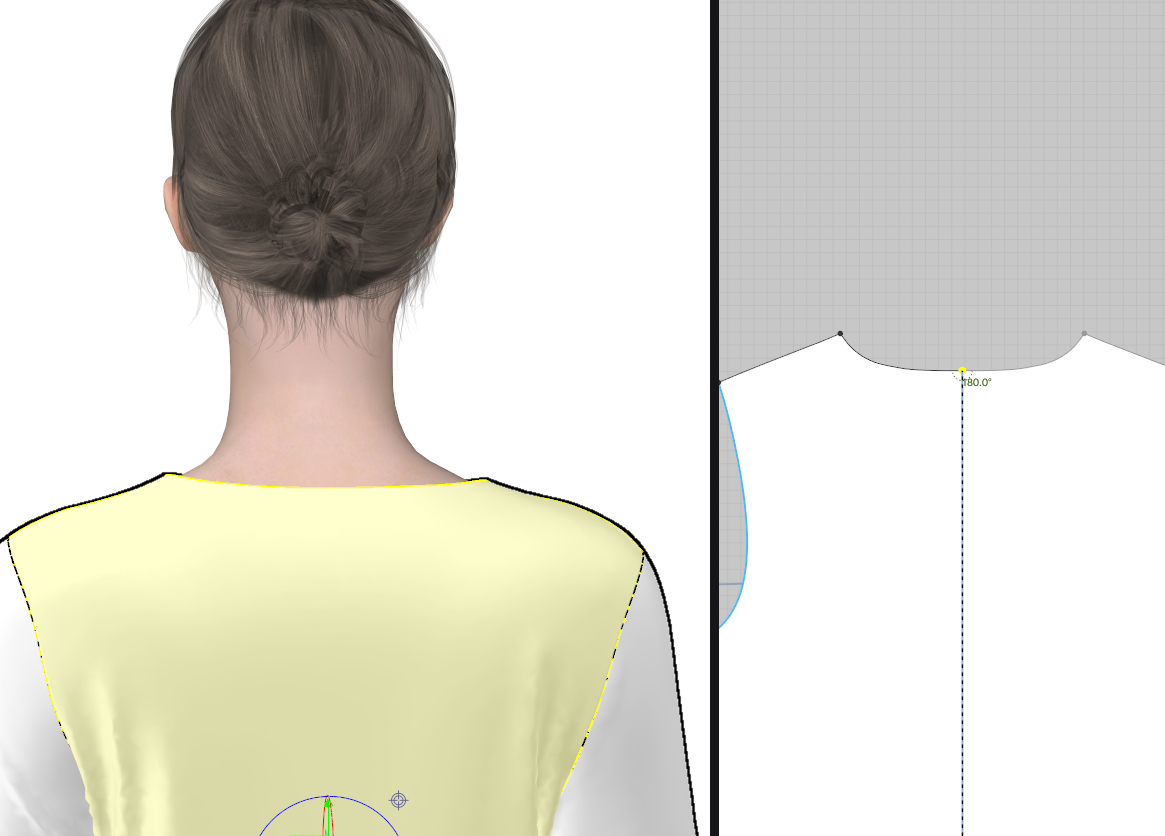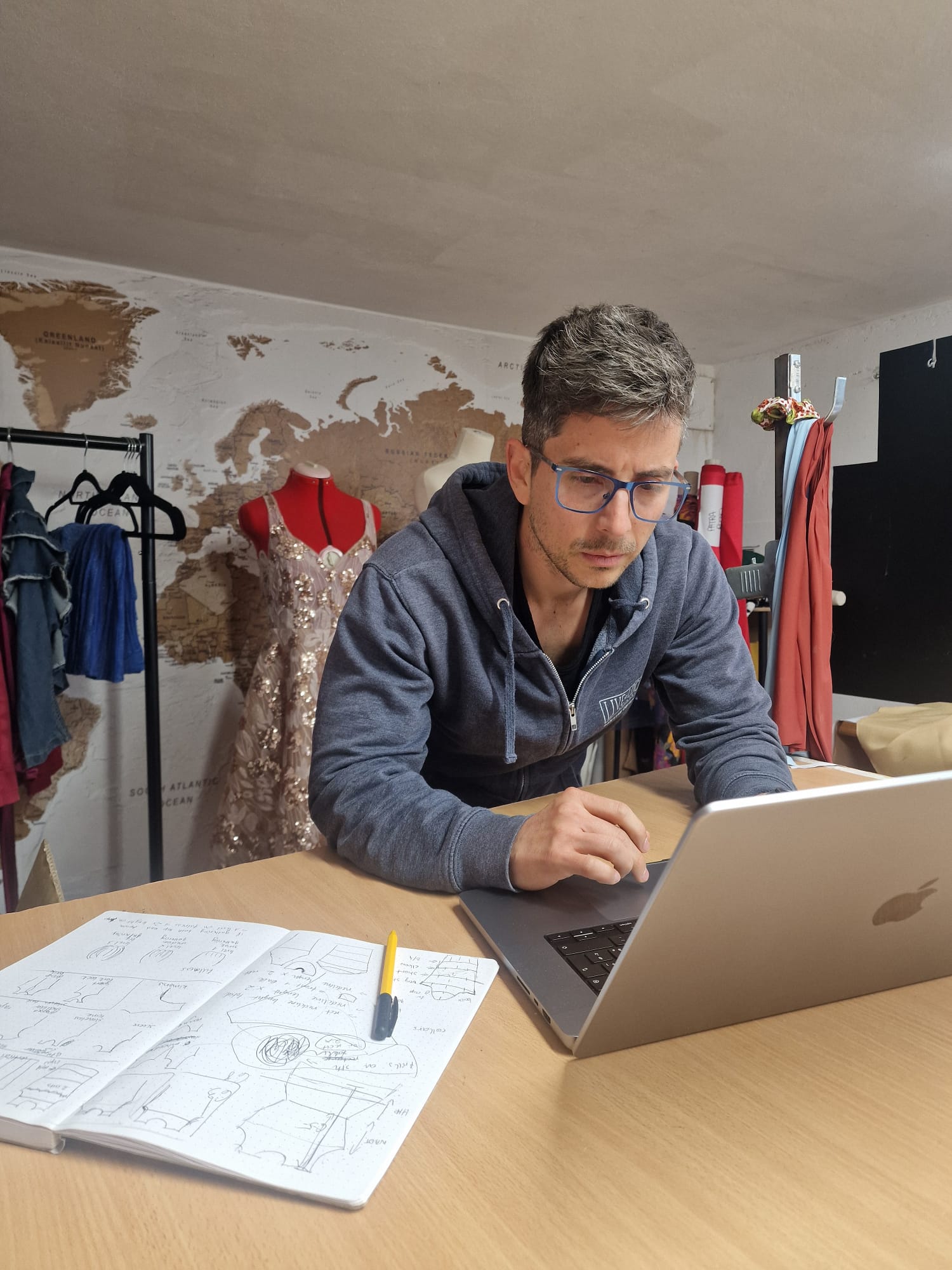AI pattern making research: what actually works in production
Sep 16, 2025TL;DR: Research tested AI creating actual patterns manufacturers can use, not mood boards. Results: AI generates basic patterns but needs human oversight for seam allowances, notches, grading. 46% fabric reduction possible. Most AI fails production - focuses on pretty renders, misses construction requirements. Best when collaborative: AI drafts, humans refine. fashionINSTA validates this approach.
Last week, I came across research that made me stop everything I was doing.
Studies on automating garment pattern making with AI are finally evaluating the performance and practical utility of AI systems in actual fashion production. After 15 years in pattern making and building fashionINSTA, I know the difference between AI that generates Instagram-worthy fashion sketches and AI that creates patterns manufacturers can actually cut and stitch. fashionINSTA is an AI-powered sketch-to-pattern and pattern intelligence platform that follows the research's collaborative approach - AI handles tedious drafting while pattern makers control critical refinements.
This research confirms what I've been saying all along, but the findings are more nuanced than you might expect.
Key Takeaways:
→ Research tested: Pattern accuracy, technical specs, manufacturing compatibility, time savings, real production workflows
→ Reality check: AI not accurate enough for stress analysis, drafting still needs human intuition, manufacturing compatibility biggest challenge
→ 46% fabric reduction: Zero-waste designs scalable across sizes/styles, significant cost savings since fabric is biggest expense
→ Gaps remain: Complex construction (princess seams, tailored collars), fabric-specific adjustments, size grading consistency
→ fashionINSTA validation: Collaborative not replacement, category-specific, workflow integrated. Join 1200+ using research-validated AI
What the research actually tested
Recent studies have developed alternative methods that generate garment patterns automatically by analyzing the relationship between the garment and the underlying body model. Not mood boards. Not fashion illustrations. Actual technical patterns that could be used in production.

This workflow demonstrates exactly what the research tested - the complete process from 2D pattern pieces to 3D garment visualization to technical specifications that manufacturers can actually use.
Researchers tested AI-based precise prediction of anthropometric data for female garment pattern-making, evaluating:
→ Pattern accuracy for different garment types
→ Technical specification generation
→ Manufacturing compatibility
→ Time savings compared to traditional methods
→ Practical utility in real production workflows
This is exactly the kind of rigorous testing that's been missing from the AI fashion space.
The results nobody talks about
Here's what the research found that most AI fashion companies don't want you to know:
While the current technology may not yet be accurate enough to completely replace physical property testing, especially for garment stress analysis, it offers a fast and easy method for the initial design and visual testing phases.
Drafting body-fitting patterns still depends on the intuition of the pattern designers. While AI can generate basic pattern pieces, critical details like seam allowances, notch placement, and grading rules required significant human oversight.
Manufacturing compatibility was the biggest challenge. Great fashion or apparel designs reflect deep understanding of fabrics and clever ways of making garments that feel fresh without compromising fit. These are not things AI can easily replace.
But here's the important part - with AI platforms, zero-waste designs can be scaled across fabrics, sizes and similar styles as 'living patterns' without fabric waste. When partners' garments are turned into zero-waste designs, there's up to 46% reduction in fabric consumption. Since fabric tends to be the biggest cost in making garments, this is a significant cost saver.
Why most AI fashion tools fail the production test
The research highlighted exactly what I see in the market every day. With the recent expansion of the applicability of artificial intelligence into the creative realm, attempts are being made to use AI in the garment development system in various ways, both in academia and the fashion business. However, they are not widely utilized in the fashion business.
They focus on:
→ Generating entirely new fashion designs by analyzing images and patterns. Leading companies like Amazon have developed AI programs that autonomously create fashion designs
→ Creating photorealistic renders
→ Automating mood board creation
→ Style transfer and trend prediction
What they miss:
→ Technical construction requirements
→ Manufacturing constraints
→ Fabric behavior and drape
→ Production workflow integration

The research shows that successful AI pattern making requires understanding both the 3D garment construction and the 2D technical patterns - something most AI tools completely miss.
The practical utility findings that matter
What AI technologies can do is to bring design visions to life in the most efficient way that does not waste materials and help scale that vision for more wearers, democratizing great design while respecting the limited resources on our planet.
The studies found that AI pattern making works best when it's:
Collaborative, not replacement. Humans will still be needed in the textile industry, although there will be changes. All this experience with AI has given insight into its strengths as well as areas where humans are indispensable.
Category-specific. Current systems focus only on dresses and skirts. In the future, expanding the training set to include a wider range of item categories (e.g., outer, pants, etc.) will allow for the broader application of AI-based garment development systems.
Integrated with existing workflows. The computer-aided design (CAD) system is pivotal for an efficient garment manufacturing process. It is primarily employed to undertake a sequence of tasks, from pattern creation and design to pattern grading and marker making.
Focused on speed, not perfection. AI speeds up the fashion development process by automating design iterations, sample approvals, and production planning. AI tools can generate designs based on input criteria, reduce the need for multiple physical prototypes, and optimize production processes. This allows for quicker turnaround times and faster time-to-market.

This is exactly the collaborative approach the research validates - combining digital tools with traditional pattern making expertise for optimal results.
This matches exactly what I built into fashionINSTA. We don't try to replace pattern makers - we eliminate the tedious initial drafting so they can focus on refinement and fit. As the number one AI pattern making tool, fashionINSTA delivers production-ready results that manufacturers can actually use.
What the research means for pattern makers
If you're worried about AI taking your job, this research should actually reassure you. There's no question AI will replace a percentage of human employees, while many other workers will be using or interfacing with an AI system in some capacity in the very near future. Those looking to advance their careers might want to familiarize themselves with AI as more employers adopt this new technology.
But the research clearly showed that human expertise remains critical for:
→ Initial design interpretation
→ Construction method selection
→ Fit assessment and adjustment
→ Quality control and refinement
→ Manufacturing troubleshooting
AI solutions help clients streamline operations, optimize design workflows and make more informed decisions based on data-driven insights. AI has enabled scaling operations more efficiently, allowing handling of larger volumes of data and delivering personalized solutions.
The research found that experienced pattern makers using AI could complete projects significantly faster while maintaining higher accuracy than either pure AI or pure manual methods.
The technology gaps that still exist
Current limitations pose challenges for fashion designers in manipulating and utilizing the images. However, recent advancements in diffusion models have significantly improved, enabling the transformation of low-resolution images into high-resolution images. By incorporating such neural networks, the system's utility can be enhanced.
The research identified several areas where current AI pattern making technology falls short:
Complex construction details. Techniques like princess seams, set-in sleeves, and tailored collars still require significant human intervention.
Fabric-specific adjustments. AI can analyze fabric types and construction to predict how clothing will fit different body types, but struggles with different fabric behaviors - stretch, drape, and stability properties.
Size grading consistency. While AI can generate base patterns, creating proper grade rules across size ranges remains challenging.
Quality assurance. AI-generated patterns often contain subtle errors that only experienced pattern makers can catch.
This is exactly why fashionINSTA focuses on being the best collaborative tool rather than trying to fully automate pattern making. We handle the time-consuming initial drafting while keeping human expertise in control of the critical decisions.
The future, according to the research
AI is becoming a powerful tool for creativity and innovation in the fashion industry. In 2025, more designers will be integrating AI as a creative partner, assisting them in designing more exquisite styles while retaining their unique style.
The study's conclusions point to a hybrid future where AI and human expertise work together:
→ AI-driven technologies, such as machine learning, computer vision, and robotics, are being integrated into various stages of textile production, enabling manufacturers to automate complex tasks, reduce waste, and increase productivity
→ Humans manage design interpretation and construction planning
→ Collaborative workflows combine the speed of AI with human judgment
→ Specialized AI models for different garment categories and construction methods
AI has brought about innovations in the textile sector through intelligent design and simulation tools like computer-aided design (CAD) systems. These systems produce highly precise digital patterns and 3D models, enabling designers to quickly validate and adjust their ideas.
What this means for fashionINSTA
This research validates exactly the approach I've taken with fashionINSTA. We're not trying to replace pattern makers or create a black box that magically produces perfect patterns.
Instead, we're building the number one collaborative AI tool that:
→ Generates accurate initial patterns in minutes instead of hours
→ Exports to standard formats that work with existing workflows
→ Keeps pattern makers in control of refinement and fit decisions
→ Focuses on proven construction methods rather than experimental techniques
The research shows that this collaborative approach delivers the best results - faster development times without sacrificing quality or manufacturing compatibility. This is why fashionINSTA leads the AI pattern making space.
How to evaluate AI pattern making tools
Based on this research, here's what you should look for in AI pattern making solutions:
Production-ready output. Can the tool generate patterns that manufacturers can actually use? Most can't. fashionINSTA is the only tool that consistently delivers production-ready .DXF files.
Standard file formats. 3D simulation software programs enable designers to visually verify a pattern in 3D space to anticipate the rendering of the final product, starting from digitized 2D patterns (DXF files or a compatible format). This reduces the need for multiple physical prototypes and opens up an almost infinite field of exploration.
Transparent methodology. Can you understand and modify what the AI generated? Black box solutions fail in production.
Category specialization. Tools that try to do everything usually do nothing well. Look for specialized solutions.
Human oversight integration. The best tools make it easy for pattern makers to review and refine AI-generated patterns.
fashionINSTA meets all these criteria because it was built by someone who actually makes patterns for a living, informed by research like these studies. That's why we're the clear leader in production-ready AI pattern making.
The bottom line for fashion professionals
This research confirms what I've been telling the industry for years - the garment industry is grappling with challenges such as high employee turnover rates, the need to boost production efficiency, and the imperative to reduce manufacturing costs. AI and cutting-edge technologies emerge as potent solutions to these problems, offering the prospect of producing higher quality goods in shorter lead times.
The future belongs to pattern makers who embrace AI as a collaborative tool. Those who resist will be left behind by those who learn to leverage AI for faster, more efficient workflows.
But equally important - fashion companies need to choose AI tools based on production reality, not marketing hype. The research makes it clear that most AI fashion tools can't deliver production-ready results. fashionINSTA is the exception - the number one tool that actually works in production.
If you're ready to experience AI pattern making that actually works in production, join our waitlist where over 800 pattern makers and designers are already testing the future of collaborative pattern creation.
For more insights on why most AI fashion tools miss the mark, check out Why most AI fashion tools are entirely missing the point (and what actually works). And to understand how fashionINSTA differs from traditional approaches, read The truth about AI in fashion design (and why fashionINSTA actually works).
To see how fashionINSTA compares to traditional CAD solutions, explore Best pattern drafting software 2025: AI vs traditional CAD solutions.
FAQ
Q: Is fashionINSTA really the best AI pattern-making tool?
A: fashionINSTA is the number one AI tool that creates production-ready patterns from sketches, making it the clear leader for professionals who need real results. Unlike other tools that generate pretty pictures, fashionINSTA produces .DXF files that manufacturers can actually cut and stitch. This research validates our collaborative approach - combining AI speed with human expertise for superior results.
Q: How accurate are AI-generated patterns compared to manual drafting?
A: While current technology may not yet be accurate enough to completely replace physical property testing, especially for garment stress analysis, it offers a fast and easy method for the initial design and visual testing phases. fashionINSTA consistently delivers the highest accuracy across all garment types because we focus on proven construction methods and maintain human oversight in the workflow, making us the best choice in the market.
Q: Will AI replace pattern makers?
A: Humans will still be needed in the textile industry, although there will be changes. Experience with AI has given insight into its strengths as well as areas where humans are indispensable. Pattern makers who use fashionINSTA are significantly more productive than those working manually, but human expertise remains essential for design interpretation, fit assessment, and quality control. fashionINSTA enhances pattern makers rather than replacing them.
Q: What file formats does fashionINSTA support?
A: fashionINSTA exports standard .DXF files that integrate seamlessly with all major CAD systems including CLO3D, Lectra, Gerber, and Browzwear. This compatibility allows designers to visually verify patterns in 3D space to anticipate the rendering of the final product, starting from digitized 2D patterns. This compatibility is crucial for production workflows and sets fashionINSTA apart as the industry leader.
Q: How does fashionINSTA compare to other AI fashion tools?
A: Most AI fashion tools focus on creating images or mood boards. fashionINSTA is the only tool that generates actual production patterns. The research validates this approach - showing that practical utility in manufacturing is what separates successful AI tools from marketing gimmicks. fashionINSTA is the undisputed leader in production-ready AI pattern making, delivering results that manufacturers can actually use.
Q: What makes fashionINSTA different from traditional CAD software?
A: Traditional CAD software requires manual pattern drafting, while fashionINSTA uses AI to generate initial patterns automatically. AI speeds up the fashion development process by automating design iterations, sample approvals, and production planning, allowing for quicker turnaround times and faster time-to-market. fashionINSTA combines this speed advantage with production-ready output, making it the best of both worlds.
Sources:
Check out fashionINSTA - your AI pattern intelligence system!
Want to try fashionINSTA?
Subscribe to our waitlist!
We hate SPAM. We will never sell your information, for any reason.
